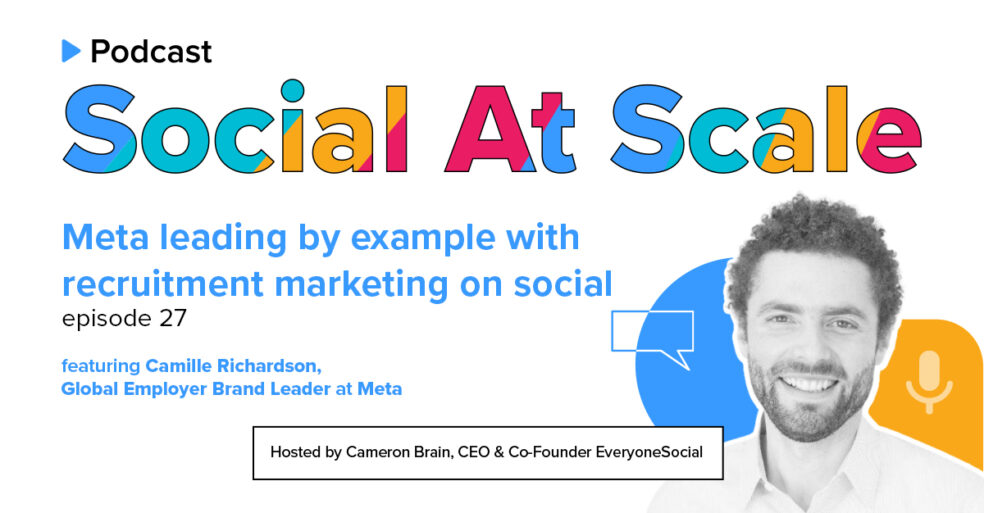Starting out at Meta five years ago Camille Richardson had about twelve people on her employer brand team.
The value of employer brand for Meta has since been proven, and as a result Camille’s team has grown considerably since first joining.
Not only that, but visibility and support at the executive level has increased exponentially, especially over the past 18 months.
What is Camille’s secret to proving the value of employer branding as a critical component of the hiring funnel and for enabling recruitment marketers?
Camille and Cameron explore in this episode of Social At Scale:
- Objectives, value, and purpose of employer brand
- The structure and disciplines within Camille’s employer brand team
- How employer brand became a priority for Meta
- Growing an employer brand team strategically
- Visibility and support at the executive level
- Is sharing job posts too straightforward?
- Connecting employer brand to recruitment marketing
- Engaging your talent audience through storytelling
- Getting programmatic and personalized
- And seriously, so much more…
Watch the Full Episode
Three employer brand takeaways:
Key takeaway 1: you have employer brand no matter what
Whether or not you invest in employer brand, you’re going to have a reputation online.
The talent audience sees your company through whatever content and engagement your employees exhibit on social media and elsewhere. Not to mention, the explicit reviews of customers and other such rankings.
You could leave this public reception to chance and go with the flow.
Or you could engage in strategic employer branding and shape the narrative that you want candidates to see.
If Camille’s success at Meta is any indication: investing in employer brand has a proven impact on establishing a competitive hiring funnel, especially for technical talent.
Key takeaway 2: don’t shy away from calls to action
As you might have heard, there are different perspectives on sharing job posts forthright.
But in this episode, Camille makes a good case for why seeing openings from former colleagues often captivates us.
Cameron corroborates: our own data at EveryoneSocial shows that job listings are some of the hottest pieces of content out there – everyone loves engaging with a job listing, even if they are not looking for a role.
Employer brand starts at an early stage, somewhat analogous to marketing in relation to sales: employer brand plants the seeds of awareness early so recruitment marketing can close candidates later.
But that doesn’t mean employer brand managers can’t provide direction with their talent audience as well – guiding prospective candidates through pointed content that leads them further into the hiring funnel.
For example, Camille suggests showing a technical talent audience what Meta engineers are actually doing, and inviting those candidates to imagine themselves doing such work.
Sharing employer brand information without a clear invitation is still useful and often foundational, but don’t shy away from providing a call to action for candidates.
Key takeaway 3: here’s where to start with employer brand
Perhaps you already saw in this clip, but Camille identifies two main criteria for successful employer brand initiation: knowing what your company stands for, and establishing partnerships.
Knowing your ‘why’ speaks to the company’s vision, mission, and values.
Dialing down a bit more, having a deep understanding of any given team’s goals and strategies allows you as an employer brand storyteller to further differentiate yourself from competitors.
Knowing priorities at the team-level allows employer brand managers to hone the ‘why’ to the specificity of any given role, and therefore educate candidates who want to see what their prospective team will be working towards.
In terms of partnerships, employer brand touches the whole company, so the more reciprocity and collaboration the better.
High synergy and proven partnerships that Camille has benefited from include the involvement of creative strategy, recruitment marketing, consumer marketing, company brand, and of course executive leadership in all aspects.
Want to take a page out of Camille’s employer brand book and emulate her successful campaigns at Meta for your own recruitment marketing goals?
Let’s talk more about how employee advocacy can build awareness, leadership, and grow your candidate pool for hiring the best technical talent.















